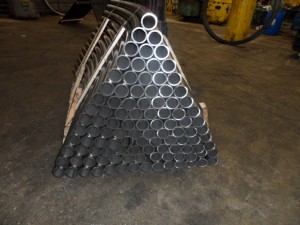When we bend tubing for customers, we want to make sure we send them the right number of pieces they ordered—not more and not less. Recently we curved 70mm OD pipe for John Deere equipment. The pipe was stacked like a pyramid with 14 units at the bottom and one at the top.
Rather than count each piece (1+2+3+4….+13+14 = ?), we used the formula,
Sum = n(n+1)/2
The bottom row of this bundle has 14 pieces, so n=14 .
Sum = 14(14+1)/2 = 105 pieces
Although this example alone does not illustrate significant time savings, the question of counting pieces in our factories is very important. All manufacturers should be striving to eliminate waste in their factories. Many times the act of counting does not really add value in the shop. Cost can be added to our products without adding value. Unnecessary moving of materials in the shop, storing material, expediting jobs, searching for parts, taking goods out of one container and putting them into another, and accumulating goods into larger quantities—all may be seen as wasted activity. Our customers certainly do not want to pay for these activities.
How can we eliminate the waste of counting, for example. Special shipping containers can be used that are standardized to hold a fixed number of parts. Once they are filled, the machine operator knows he has produced, say, 10 parts. Or, if inventories are kept low in a just-in-time environment, fewer parts have to counted. If parts are made where there is one-piece-flow through, say, 3 operations, only the final output need be counted. If the three operations are done in three batches, the pieces need to be counted three times. Lastly, if parts can be built to order, then there would be no need to accumulate (and count) them in inventory.
These are just some of the techniques to eliminate waste used in world-class manufacturing plants.








